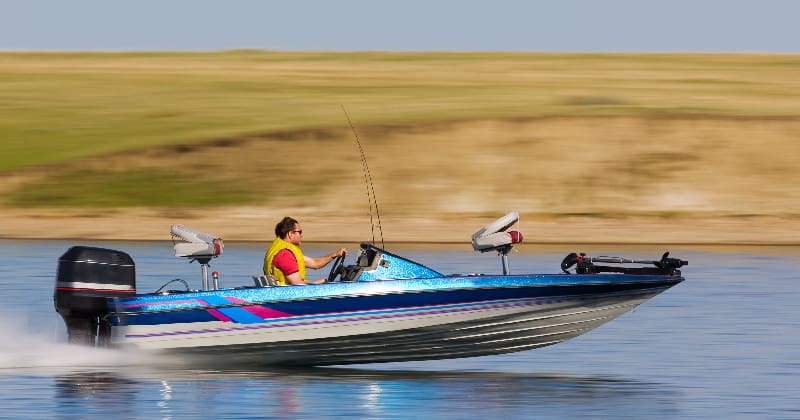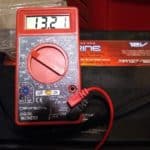The right size trolling motor can be difficult to determine because size can imply a few different parameters including motor thrust and motor shaft length. You need to factor in different variables depending on your usage of your boat to determine the best size trolling motor for your boat.
How do you use your trolling motor?
First, let’s narrow down your options by figuring out how you use your boat. They call it a trolling motor, but do you use your motor to troll, or are you mostly stationary?
Most people who fish for trout, salmon, or kokanee (salmon), predominantly troll in lines or patterns. For this type of fishing, trolling, you need a motor that can move your boat throughout the day at catching speed and keep your pattern going with ease.
Other fishermen target fish like bass and walleye by moving the boat in small steps, from spot to spot very slowly. At each spot, they might cast a crankbait, or a jig and work it. Then reel it back to the boat in a casting pattern. After they have covered that spot casting, they move the boat to the next spot.
In this type of fishing your motor is more about finesse and subtle control than high power. Additionally, easy to deploy and stow might be a top feature because you will be stowing your motor
Bow or stern mount
Now that we have talked about how you use your boat, you can about the type of motor you need. Electric motors come in three main types bow-mounted, stern-mounted, and engine mounted.
Bow mounted motors pull you through the water from the front of your boat. There are a few main advantages to bow mount motors most notably control and the ability to maneuver your boat in almost any direction.
Another advantage would be the long list of high-end options, including autopilot, built-in sonar, optional foot controls, and auto-deploy (on Minn Kota). There are a few notable disadvantages to a bow mount motor like the amount of deck space it takes to stow it and all of the wiring required. Additionally, something not much talked about in the industry is that bow mount motors are power-hungry.
Stern mount motors, like gas trolling motors, push your boat through the water from the back of your boat. The main advantage of this is the simplicity of operation and installation. Smaller stern mount motors clamp onto the back of your boat in minutes are simple to attach to your battery.
If you are using a smaller boat, or are fishing on a gas-free lake, a small electric motor could be your only option. The biggest disadvantage of a stern mount motor is the lack of high-end options.
Engine mount electric motors push your boat in the same way as a stern mount motor. The electric motors bolt to the top of your main motor’s cavitation plate (or outdrive’s cavitation plate) resulting in controlling your boat’s direction with your main steering.
The engine mount motors were originally recommended and designed for inboard/outboard type boats. There is not a good location to mount a trolling motor on the stern of these types of boats, so bolting the motors to the top of the outdrive is a great option. Also, these motors are not made in smaller sizes, which can run up the cost. Even so, you benefit in more power for the larger size of these style boats.
Check out this article on my site with more details about bow and stern mount electric motors.

Bass fishermen
I want to cover bass fishermen and motor selection. Almost every bass fisherman is going to want a bow mount electric trolling motor.
As I mentioned previously in this article, bass fishermen don’t need constant power; they need finesse. Along with finesse, they also need a motor that offers optional hands-free controls, like a foot pedal.
I still prefer saltwater motors, and electric-steer motors are the best.
Check out this article on my site about the best all-around motor for your bass boat
Freshwater or saltwater
Most motors these days are made in a fresh or saltwater version, with the saltwater version being 20 to 30% more expensive. It is important to make sure you get the right version because it can cost you if you don’t.
Saltwater motors like the Minnkota Riptide series are built for saltwater. The Riptide series is corrosion-resistant and has a large saltwater anode on the propeller shaft.
If you fish on a lake or live nowhere near a body of saltwater, then this should be an easy question to answer. Also, most of the specialized bass motors, like the new Garmin Force, are only available in freshwater versions.
However, in my opinion, I would only buy a saltwater motor because saltwater or not, they are built with better parts and it is one less thing to worry about.
Water conditions
Your fishing environment can be a big factor in selecting your motor’s thrust and shaft length. If you are fishing in shallow water, you need to have a short-length motor shaft or a wide range of adjustments.
In deep water, you can use a longer-length motor shaft, as long as you meet the minimum depth. Most motor manufacturers recommend that your motor’s drive unit be submerged at least twelve inches.
If you are in rough water conditions, such as river traffic waves or wind waves, most manufacturers recommend five additional inches of water. I have years of experience in rough bay water, and I don’t agree with five inches. I recommend nines additional inches of water at a minimum.
The reason for my recommendation is simple. As your boat bounces in the waves, your motor will pop out of the water, resulting in a loss of control. Remember, you will need to be aware of objects in the water like logs or grass.
Additionally, the motor could heat up when running at a higher power setting. This is a direct result of the motor being out of the cool water.
If you fish in small lakes or ponds, where the water is relatively calm most of the time, the standard twelve inches should be fine. If you decide to fish somewhere else, you may need the extra depth.
Height of your boat
Measuring the height of your boat is crucial to getting the correct length shaft for your motor.
To get a good measurement, you need to put your boat in the water, but don’t forget your gear. The amount of gear and people you have in your boat affects how high it sits in the water.
If you plan to fish in mostly shallow water, load your boat to a maximum fishing weight load including gear and people. This will push the boat to the lowest position in the water and help prevent your motor from being too deep.
When running your boat in deep water, you’ll do the exact opposite. Load your boat with the minimum fishing weight load, including gear and a person. Your boat will ride high in the water, and then you can measure the height to get the proper length of the motor shaft.
After your boat is properly loaded, take it to a calm boat ramp and put it in the water. Place a stick in your mounting location, and measure from the bottom of the stick to the water.
Motor shaft length
We have talked about factors to adjust when deciding your motor shaft length. Additionally, we have covered tips for getting a good measurement on your boat. Now it’s time to put it all together and pick a shaft length.
This is a bow mount trolling motor shaft length formula.
height x 1.5 + depth in water = shaft length
When you use this formula, height is the measurement you took from the mounting location to the water. Depth in the water is the standard twelve inches plus the allowance for water conditions.
| boat height from water | minimum shaft length |
| 16″ | 36 |
| 22″ | 45 |
| 28″ | 54 |
| 34″ | 63 |
| 40″ | 72 |
Note: we recommend adding an extra 5 inches to the shaft length for a pontoon boat to ensure better boat control.
One more factor that you will need to consider is how much space will your motor needs to stow. Add five inches to the length of the motor shaft and measure out your installation location to make sure your shaft is not too long.
Transom mount trolling motors are much easier to deal with. Most electric trolling motors have some form of adjustment, like a depth collar. A depth collar works out perfectly for a transom mount motor.
If you go with the longest shaft you can buy, then adjust the depth so that the power unit is just under the boat. You will get a good bite with the propeller and be able to use the control handle without stress.
You can follow this link to the Minn Kota website for their shaft sizing guide.
When looking at an electric trolling motor, the shaft length is the measurement from under the control head, to the power unit (propeller housing).
Weight of your boat
When asking how much thrust do I need for an electric trolling motor? one of the most important factors is the weight of your boat. A simple formula of total weight divided by 50 equals the minimum thrust required for your boat weight. Don’t forget the weight of your boat includes everything in your boat; your fishing gear, fuel, yourself, your buddies, and your cooler.
If you buy a new boat, it will come with a manual that tells you the dry weight of the boat. From there you can look up the dry weight of your motors and add the fuel weight.
Grab your tackle box and your fishing poles, and jump on the bathroom scale. Add that weight to the list. Next, add around 200 pounds per person for your fishing buddies.
Here is the big thing that everybody misses: you have to include the weight of your electric trolling motor and batteries. As a basic formula, I add 70 pounds for the motor and 140 pounds for the batteries. Every system is different, but this is a safe starting point.
For more information on motor and battery weights, click here to read my article.
Now that you have a total weight, you can select a minimum thrust requirement for your electric trolling motor. Keep in mind that you will also want to meet the minimum requirements for the size (or length) of your boat.
Each manufacturer recommends a bit different amount of thrust by weight, ranging from 2 to 2.5 pounds thrust per 100 pounds of total weight. If you use 2 pounds thrust per 100 pounds weight, you will have a good minimum thrust rating by weight.
This is a minimum thrust rating by weight formula.
Total weight / 50 = minimum motor thrust by weight
| Total weight | minimum thrust |
| 2000 | 40 |
| 3000 | 60 |
| 4000 | 80 |
Length of your boat
Boat length might be the easiest topic to discuss. If you don’t know your boat length, most states register boats by length for their fee structure, so take a look at your registration.
You will need to take that length and round it up to the nearest foot, to correctly calculate your minimum motor thrust by length, and round thrust up.
This is a minimum thrust rating by length formula.
(length-10) x 6.4 + 10 = minimum motor thrust by length
| boat length | minimum thrust |
| 14 | 35.6 (36) |
| 18 | 62.2 (63) |
| 20 | 74 |
| 22 | 86.8 (87) |
Power consumption
Last but not least, power consumption can be a big factor when fishing with larger boats.
You should consider adding extra battery weight to your calculation if you fish long days in a large boat. I run four batteries on a 24-volt system to get through my fishing day.
Click here to read our review of Trolling Motor Batteries
Conclusion
“What size trolling motor do I need for my boat?” is a question with many variables to consider. Go through each variable and get the minimum size or thrust, then look at your options from your preferred manufacturer.
My advice to you is always to buy the next size bigger than you think you’ll need, as long as it fits on your boat. It can cost a lot to replace a motor simply because you bought one size too small.
Frequently Asked Questions
How fast will a 55lb thrust trolling motor go?
You can expect your 55lb thrust trolling motor to travel roughly 5 miles per hour. The speed of 5 mph will depend on the conditions of the water. You will only see the top speed when you are riding in perfect conditions, along with the best fuel and weight of the load.
To achieve five mph, you will want a moderate load. The more weight that you put on, then the slower your motor will go.
When running at five mph, you can expect your battery to last for about two hours. A deep cycle battery will last for two hours before it is drained completely, and it will need to be recharged.
Two hours and a speed of 5 mph are more than enough for most people, though!
How do I know what size trolling motor shaft I need?
To know what size trolling motor shaft you need, you will need to do some measuring! You must get the size right so that your motor can run properly and not make any noises that will spook the fish!
To do this, you want to measure down from the mounting surface of the transom or bow to the water level. Add five inches to the waterline measurement if you fish in rough water.
You should then add 12 inches to the waterline measurement for steering a hand-controlled motor when standing. We generally say that the top of the motor section should be submerged by 12 inches.
Once you have these measurements, you will be able to determine what size trolling motor shaft that you need! You can also check size guides on product listings too; these can be helpful if you aren’t sure what size you need.
What size trolling motor do I need for a 15-foot boat?
You will also want the motor to run on 12 volts. The size of the motor is also determined by the boat’s weight. For a 15 foot boat, you will want 40 to 45 lbs (in terms of thrust). If your boat weighs more than 2,000lbs, you will need a larger boat.
These are just rough guidelines and will depend on your boat. In most cases, you can enter the details of your boat and find the exact size motor that will be perfect.
Most motors will come with specifications that will state what size boat they are best for. Be sure to check these before making any purchases to ensure they are the right size.
Providing that it does not exceed 50 thrusts and runs on 12V, the motor should be suitable for your 15-foot boat.
How deep should a trolling motor be in the water?
Your trolling motor should be submerged 12 inches below the waterline. The trolling motor needs to be submerged appropriately for the motor and your boat to function properly.
You will want it deep enough to run through the water problem-free, without drawing any unwanted attention from the fish!
You want to be careful that you don’t submerge it too deeply, though. If the trolling motor is submerged too deeply, it can damage your motor, leaving you with irreversible damage!
When installing your motor, it will say in the manual how deep it needs to be submerged in the water.
Your measurements must be correct to ensure your motor runs as it should and does not encounter any damage while it is in use.
If you have any concerns, you can always ask a professional to help install your trolling motor so that it’s at the correct level to be submerged.



